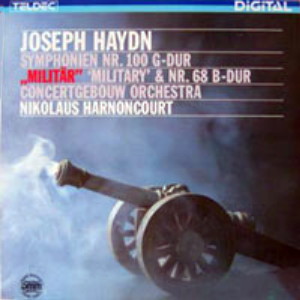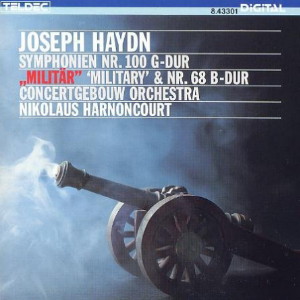 |
1 LP -
6.43301 AZ - (p) 1986
|
 |
| 1 CD -
8.43301 ZK - (p) 1986 |
|
| Franz Joseph
Haydn (1732-1809) |
|
|
|
|
|
|
|
Symphonie Nr. 100 G-dur
"Militär"
|
|
24' 48" |
|
| - Adagio - Allegro |
8' 15" |
|
A1 |
- Allegretto
|
6' 02" |
|
A2 |
- Menuett: Moderato
|
5' 11" |
|
A3 |
| - Finale: Presto |
5' 20" |
|
A4 |
Symphonie
Nr. 68 B-dur
|
|
29' 01" |
|
- Vivace
|
7' 01" |
|
B1 |
| - Menuetto |
3' 13" |
|
B2 |
| - Adagio cantabile |
14' 11" |
|
B3 |
| - Finale: Presto |
4' 36" |
|
B4 |
|
|
|
|
| CONCERTGEBOUW ORCHESTRA,
AMSTERDAM |
|
| Nikolaus
Harnoncourt, Dirigent |
|
|
Luogo
e data di registrazione
|
| Concertgebouw,
Amsterdam (Olanda) - ottobre e novembre
1986 |
|
Registrazione
live / studio
|
| studio |
Producer
/ Engineer
|
Wolfgang
Mohre / Helmut Mühle / Michael Brammann
|
Prima Edizione CD
|
| Teldec
- 8.43301 ZK - (1 cd) - 54' 11" - (p)
1986 - DDD |
Prima
Edizione LP
|
Teldec - 6.43301
AZ - (1 lp) - 54'
11"
- (p) 1986
- Digital
|
|
|
Notes
|
Eduard Jacob’s
monograph on Haydn
draws attention to the magical ambiguity
of the martial percussion instruments,
which simultaneously express courage
and fear. The shattering effect of the
drum beats in the “Missa in tempore
belli” [Paukenmesse - Kettledrum
Mass], and the use of“Turkish
Instruments” in Mozart’s “Entführung”
and in the so-called “Military
Symphony" are all derived from this
ambiguity. This symphony, however,
certainly does not extol militarisni
and the glory of war - there is no
heroic, inspiring march such as might
have been taken for granted in a work
of this nature;
instead, the image of the most
enchanting and tender harmony
imaginable is quite unexpectedly and
brutally shattered. The musical
conflicts within the introduction with
its exceptionally warm and tender
opening bars and the first
movement (allegro) remain within
the framework of Haydn’s
dramatic language. The second
movement, a gentle allegretto, the
tune of which may
well be based on a
traditional love song, calms all these
conflicts, until suddenly and without
any warning whateeer the idyllic mood
is shattered by the Turkish
instruments: the triangle (with rings,
creating a continual metallic sound),
cymbals and the Turkish drum, which is
beaten alternately by a
heavy club
and a whip, producing the impression
that someone is being whipped and
beaten. The two types of drum beat are
indicated in the score by the
different direction of the tails ofthe
notes. At that time “Turkish”
instruments were used exclusively in
military bands and banished from the
classical orchestra; since they
produce nothing but noise without
any definite pitch, they were not felt
to make any musical contribution to
contemporary aesthetics of sound. The
simultaneously stimulating and
terrifying effect of genuine
Janissarymusic
had led to the inclusion similar bands
in thc l8th century in Westem armies.
Consequently the Turkish percussion
instruments, in particular, which were
only used in military bands,
immediately aroused martial
associations.
With the first entry of
those instruments in Haydn’s symphony,
the bright C major darkens
to a lament in C minor. The response
to this brief outburst is a gentle,
incredulous dialogue between the
strings and the woodwind, which is
soon shattered. From then on the
movement is characterised by the
alternation of inhuman cruelty and
loving tenderness, until this dialogue
is interrupted by an unmistakeable
trumpet call. The listeners as it
were, called to arms, the music
implying a state of general
mobilisation, and the orchestra
replies with an unarticulated scream,
the only fortissimo in
the whole movement. At that time it
was unheard of for an
emotion - in this case terror - to be
expressed for several bars at a
stretch by nothing but
sound, a descending
chord of A flat; there is no theme, no
motif, no rhythm. This scream
is followed by a hesitant, almost
despairing response from the woodwind,
a motif from the song
with which the movement opened, but
this is quelled by the militarz flourishce
of the final bars.
The minuet enables
us to forget all the alarms with its
happy combination of the early baroque
minuet, the English country dance and,
first and foremost, the Austrian Ländler.
In the finale
Haydn made use of a popular English
dance tune, endowing
it with wit and boisterous good
humour, giving no indication at first
that this happy mood is also doomed to
destruction.
Of course these features had a far
greater impact in Haydn’s day than
they do now, since “Turkish
instruments” have long since become a
much used section of the orchestra. At
that time there was talk of
"intolerably loud
Janissary music... with a monstrous
drum... which a fellow thumpeed
with might and main”.
- If ever there was a
musical please for
peace, love, happiness and the
rejection of brutality, it is this
anti-Military Symphony.
Nikolaus
Harnoncourt
Translation: Clive Williams
|
|
Nikolaus
Harnoncourt (1929-2016)
|

|

|
|